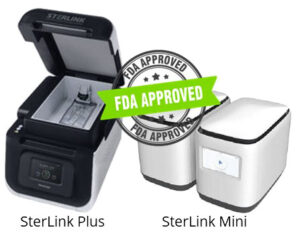Disinfection
Spore Kill Rates1
Sterilization
◊
Arguments against using High-Level Disinfection (HLD) as a substitute for sterilization are backed by heavyweights in the field, including the CDC and AAMI. Sterilization methods, such as vaporized hydrogen peroxide, have the capacity to eliminate all forms of microbial life, including hardy bacterial spores.
HLD, while effective against a broad spectrum of microorganisms, may not reliably eliminate bacterial spores.
This makes sterilization the only method for reprocessing critical surgical instruments that come into contact with sterile body tissues.
Not sure if mucous membranes will be intact or not? Sterilization is the standard to ensure a patient’s safety.2

Residual chemicals left after high-level disinfection (HLD) can pose significant risks to both patients and healthcare workers. Here are the main issues associated with residual chemicals after HLD as compiled from the publicly available writings of U.S. Center for Disease Control (CDC) and industry experts:
Hydrogen Peroxide (H2O2) sterilization has been the preferred choice for (really) fast, low-temperature sterilization in hospitals for two decades. However, cost, operational challenges and infrastructure requirements have kept this technology out of reach practices – until now.
Introducing SterLink, the world’s first and only countertop H2O2 sterilizer.
FDA-approved, SterLink delivers the same high-quality sterilization results as industrial-sized units but in a compact (7/14 liter) format—and at a fraction of the cost.
With sterilization cycle times ranging from just 14 to 34 minutes, SterLink is the ideal solution for practices where speed and safety are paramount.
How it works
Plasma (the fourth state of matter) sterilization works by disrupting microbial cell walls and DNA causing bacterial inaction while preserving the integrity of the underlying materials.
Transformative Technology
With a global installation base and multiple government approvals, SterLink sets the standard for efficacy, efficiency and safety in sterile processing.
See it in action
Contact your local SterLink representative to schedule a live video demonstration to discover how your practice can achieve new levels of productivity and excellence.
1. Rutala PhD., W; High-Level Disinfection,Sterilization and Antisepsis;UNC ChapelHill, NC, USA
2. Ref: https://www.incision.care/blog/diving-deep-into-high-level-dHLD = disposal issues
Steri101 – All Rights Reserved
We do not use cookies or automatically capture your information.